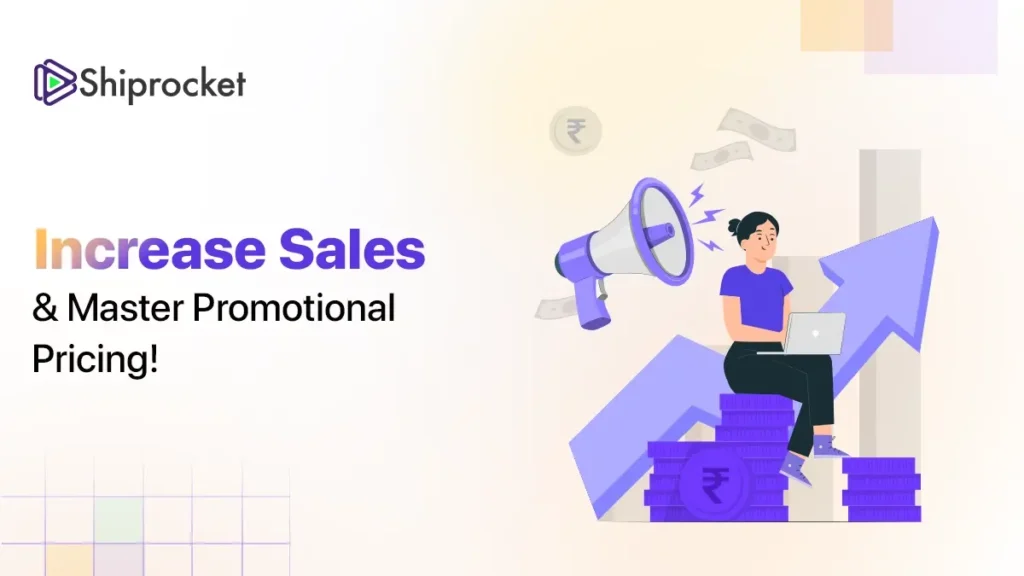Promotional Pricing: Types, Strategies, Methods & Examples
- Promotional Pricing: Understand the Strategy
- Applications and Users of Promotional Pricing
- Different Types of Promotional Pricing with Examples
- Benefits and Drawbacks of Using Promotional Pricing
- Methods for Calculating Effective Promotional Pricing for Your Business
- Identity Marketing Approaches and Promotional Pricing
- Real-Life Examples of Effective Identity Marketing Strategies
- Conclusion
In the fiercely competitive field of eCommerce, a well-thought strategy is required for ongoing success. You can build a solid brand, attract more customers, and boost sales by implementing promotional pricing. For optimal effectiveness, it is necessary to examine all of the relevant factors thoroughly. This article will help you make better judgements and enhance your eCommerce success by discussing various promotional pricing strategies, their advantages and disadvantages, and best practices for execution.

Promotional Pricing: Understand the Strategy
A strategically-planned approach is necessary for sustained success in the highly competitive online marketplace. Promotional pricing is an effective way to increase sales and profitability for your eCommerce business. Using promotional pricing is a smart way to provide your online shoppers with a temporary price reduction or other incentive. More than just a sale, it serves as a vehicle to accomplish particular objectives such as:
- Increasing the amount of sales
- Getting rid of inventory
- Bringing in new customers
You can encourage customers to act immediately by creating excitement and offering short-term discounts or promotions. It’s a calculated approach to achieving your financial objectives as a business.
A deeper examination of promotional pricing is provided in this guide. You could apply this knowledge to your advantage and accomplish your eCommerce objectives.
Applications and Users of Promotional Pricing
Due to its flexibility, promotional pricing is a widely used tactic in all kinds of businesses. Here’s how you, as an eCommerce seller, may leverage its flexibility to achieve your goals:
- General retailers frequently employ seasonal promotions to lower inventory and increase sales.
- Subscription service providers use free trials and first-time discounts to draw in fresh customers. This raises the possibility that they may sign up for long-term subscriptions by enabling them to try your goods or services.
- Software providers use time-limited deals, packages, or educational discounts to promote purchases. Provide brief discounts on software packages or licences.
- Travel and lodging companies strategically employ promotional pricing. To fill empty rooms during off-peak seasons, hotels may offer lower prices or packages. To fill empty seats, airlines may conduct last-minute or flash sales.
This article will examine several pricing techniques for promotions tailored to eCommerce enterprises. You’ll discover how to successfully apply these strategies to meet your objectives for profitability and sales.
Different Types of Promotional Pricing with Examples
There’s more to promotional pricing than just cutting costs. Here, we look at several techniques that you, as an eCommerce business, can use to draw clients and boost sales:
- Percentage Discounting
This simple strategy includes giving a straight discount on the initial price, stated as a percentage. “Buy now and enjoy 30% off!” is one example. This tactic is simple to follow and can work well for customers on a tight budget.
- Buy-One-Get-One (BOGO) Deals
BOGO sales encourage purchases of greater value. The perceived double value attracts customers, raising average order value and sales volume. “Buy one shirt, get another free!” is one such example.
- Packaged Deals
Make product bundles that are less expensive than purchasing each item separately. Based on the demands of the customer, group complementary items. Consider a skincare bundle that includes toner, lip balm, cleanser, and moisturiser.
- Limited-Time Offers (LTOs)
Set a time limit on sales to generate buzz and encourage rash purchases. By instilling a fear of missing out, excess inventory can be eliminated. “Get 40% off all products for one day only!” is one example. Overuse of LTOs may reduce their effectiveness.
- Loyalty Schemes
Maintain a record of valuable clients based on previous purchases and encourage repeat business by providing special offers, discounts, or coupons. Urge your clients to continue purchasing from you if you want to maintain those advantages.
Benefits and Drawbacks of Using Promotional Pricing
While implementing promotional pricing has many benefits, some disadvantages should be carefully considered and eliminated.
Benefits:
- Increased income and sales: Sales might spike when strategic discounts are applied. When customers are given exciting offers, they are more likely to make a purchase, which significantly increases the revenue. This temporary boost in sales can be beneficial for new product launches or slow periods.
- Reduced inventory holding costs: Seasonal or excess stock can lock funds and storage space. Promotional pricing can stimulate customers to purchase your products at lower prices. This can help you clear out your storage and use the space to accumulate products which are more in demand.
- Long-term customer relationships: Consumers value and appreciate your brand. Providing your loyal customers with exclusive discounts could persuade them to continue shopping with you. Social media networks offer a simple means of maintaining contact with your audience.
Drawbacks:
- Declining profitability margin: Increasing sales and revenue are the positive consequences of promotional pricing. But it does not guarantee an increase in profit margins. Pricing strategy must be well-implemented considering the cost structure of your products.
- Risk to the reputation of your business: Inadequate planning, like offering your products at lower rates for an extended period may cause the customers to wonder about the quality of your products. If you use promotional pricing way too much and too frequently, then there is a high chance that your audience will only make purchases at discounted prices.
Methods for Calculating Effective Promotional Pricing for Your Business
You can use the cost analysis technique to determine your products’ best discounted prices should be. For every unit, determine the production and overhead costs. Calculate different discount percentages to determine the one that will maintain an optimum level of profit margin.
Use competitive analysis to identify your direct and indirect competitors. Systematically gather information to compare your pricing strategies with competitors in similar locations. With the help of social media platforms, look at their marketing campaigns, discounts offered, and sales trends.
Recognise how your clients respond when product prices fluctuate. Keep an eye on how much people are willing to pay for your product based on various criteria, including its overall worth to the customer, emotional appeal, features, customer service, and quality.
Steps to Identify the Best Promotional Pricing
- Step 1: Clearly state your objectives for the promotions, whether they are increased sales or inventory clearance.
- Step 2: Decide which market segment the promotion intends to attract and determine your target audience.
- Step 3: Select the right kind of products or services that are most appropriate for the promotional pricing plan.
- Step 4: Formulate your pricing strategy and discount levels based on your estimates and goals, and choose the best promotion type and discount percentage.
- Step 5: Decide on a promotional time frame. Instilling a sense of urgency is always favourable. Give the promotion a specific deadline.
Identity Marketing Approaches and Promotional Pricing
Targeting and identifying customers according to their distinct characteristics, interests, and values is known as identity marketing. This strategy makes it possible to provide each consumer with offers and messages specifically tailored to them. Promotional pricing is a strategy used to entice consumers to take action, whereas identity marketing aids in identifying the appropriate audience.
What are Student Seed Marketing and Identity-Based Promotions?
Identity-based promotions customise promotional offerings by utilising client data and demographics. For example, student seed marketing encourages early brand acceptance by offering special discounts or incentives to students.
Real-Life Examples of Effective Identity Marketing Strategies
- Online retailers: Offer targeted discounts and make product recommendations based on past purchases.
- Streaming Services: Provide student discounts or free trials after age verification.
- Fitness Centres: Provide new members with introductory memberships at a discounted price.
Businesses may design targeted campaigns that resonate with particular client segments by personalising promotional pricing. This will increase conversion rates and make better use of promotional methods.
Conclusion
Promotional pricing is a powerful tool for driving eCommerce success, but it requires careful planning and execution. By leveraging various strategies, such as percentage discounts, BOGO deals, and limited-time offers, you can effectively boost sales, attract new customers, and manage inventory. However, it’s essential to balance these promotions with your overall pricing strategy to maintain profitability and protect your brand’s reputation.
By understanding the benefits and drawbacks of different promotional pricing techniques and applying best practices, you can make informed decisions that align with your business goals. Embrace the flexibility of promotional pricing to enhance your eCommerce strategy and achieve your desired outcomes.





